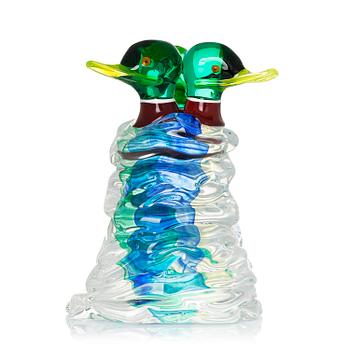Contemporary Art & Design presents Ernst Billgren
Ernst Billgren "Från Adrianopel till Astrabad"
Bukowskis presents the work "Från Adrianopel till Astrabad" by Ernst Billgren at the upcoming auction Contemporary Art & Design – The Only Dedicated Live Auction in the Nordics For Contemporary Art and Design.
"Från Adrianople till Astrabad" from 2006 is a central work in Ernst Billgren's oeuvre. The painting serves both as a manifesto of his thematic world and a summary of the blind alleys he has laid out for viewers over his career. Its monumental format and impressive richness of detail immediately transport us into his playful and peculiar realm, populated by his characteristic animal figures.

The painting was included in Billgren's acclaimed exhibition "Tjuvar" (Thieves) at Galleri Lars Bohman in Stockholm in 2006, where he allowed the animals, with their carefree expressions and splendid attire, to take centre stage in the sophisticated environments of humans. The catalogue was cleverly arranged, and the paintings were accompanied by excerpts from interrogation protocols from investigations of thefts, where the thieves, with all manner of absurd excuses, attempted to justify their actions. In connection with the release of the graphic portfolio "Tjuvar" in 2007, Billgren commented: "Like a thief in the night, nature enters our homes without first knocking on the door, just as we once took over nature, felled its trees, dug holes in the mountains, and stole the inhabitants of the forest; it now stands stamping in our porches for a return visit. What are they doing here? What will they take with them? Like thieves in the afternoon, the animals have dressed in their finest clothes to reclaim what they perceive as theirs and can lay their paws on. Is it time to flee into the forest?"
As a debater, author, furniture designer, and filmmaker, Ernst Billgren has made an undeniable mark on contemporary art, not least with his questioning of the concept of art. Even as a young student at Valand Academy of Art and Design in the 1980s, he made a strong impression on both fellow artists and the faculty. He invited students, teachers, and professors to a performance with the question "What is the difference between good and bad art?". The turnout was large, and it ended with a lively discussion, with Billgren as moderator, where both teachers and students expressed their opinions. Since then, he has continued to fascinate and surprise both the informed art audience and a broader public with his use of unconventional methods and his many references to art history. Both as an artist and a debater, he has constantly posed questions about what art is, what its purpose is, and where its boundaries lie. He continually challenges established patterns, and his art often becomes semantic inquiries into what the definitions of our most ingrained concepts are—and perhaps what they ought to be.

Inspired by the Brothers Grimm's fairy tales, animals early on became a tool for Billgren. In his book "What is Art and 100 Other Very Important Questions," he posed the question he claims he is most often asked: "Why are you so interested in foxes?". The answer was:
"Short answer: Which foxes? Long answer: If you enter a chemist's laboratory, you will surely discover lots of test tubes, and you might conclude that he is interested in test tubes. But I don't believe that. He is probably after discovering a new enzyme or element, or finding a cure for some disease. The test tubes are tools, and he likely does not see them at all and has no interest in them or in foxes."
From spring to autumn 2025, Ernst Billgren will be featured with several new works in the exhibition "Ernst Billgren – New Memories" at the Nationalmuseum in Stockholm.

The work will be sold at Contemporary Art & Design
Estimate: 600 000 – 800 000 SEK
Viewing: April 9–14, Berzelii Park 1, Stockholm
Open weekdays 11 AM – 6 PM, weekends 11 AM – 4 PM
Live auction: 15–16 April, Arsenalsgatan 2, Stockholm
Read more about Contemporary Art & Design
All works by Ernst Billgren at Contemporary Art & Design

Vasarahinta
26 000 SEK
Lähtöhinta
25 000 - 30 000 SEK

Vasarahinta
55 000 SEK
Lähtöhinta
35 000 - 40 000 SEK

Vasarahinta
46 000 SEK
Lähtöhinta
35 000 - 40 000 SEK

Vasarahinta
Ei myyty
Lähtöhinta
600 000 - 800 000 SEK
Requests & condition reports Contact specialist

Tukholma
Andreas Rydén
Varatoimitusjohtaja, Johtava asiantuntija, taide
+46 (0)728 58 71 39

Tukholma
Louise Wrede
Asiantuntija, nykytaide, Private Sales
+46 (0)739 40 08 19

Tukholma
Karin Aringer
Asiantuntija – nykytaide ja valokuva
+46 (0)702 63 70 57






























